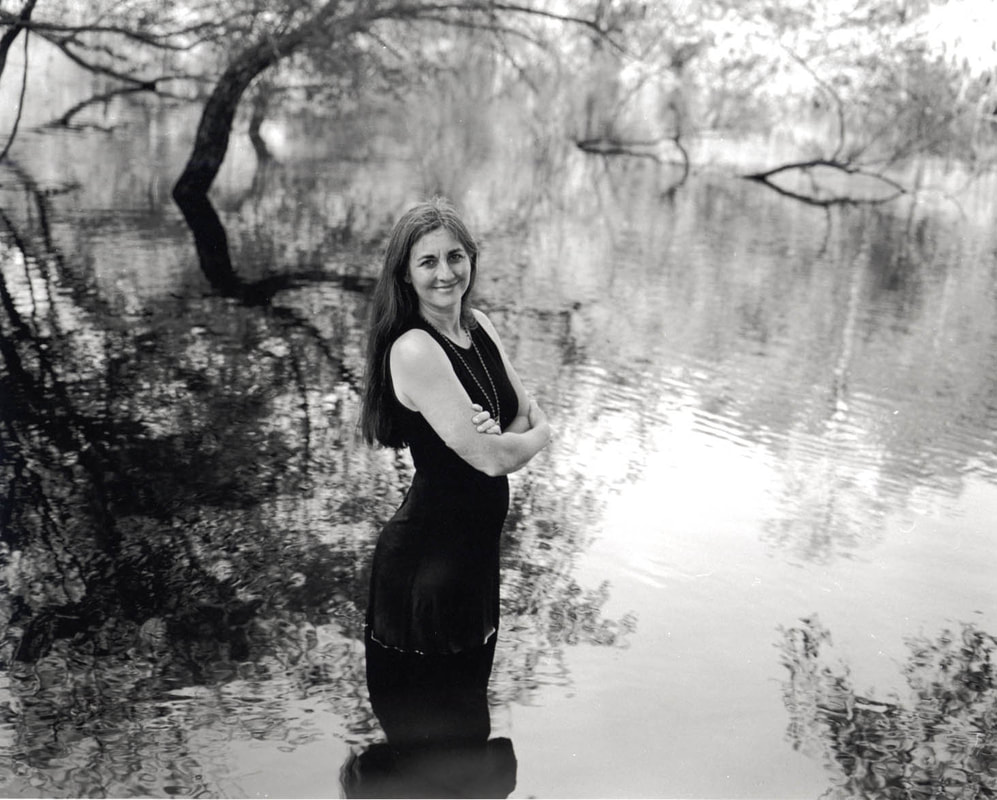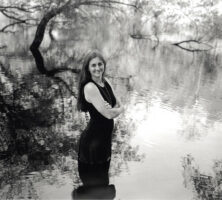Janisse Ray, an environmental activist and poet, is the award-winning author of Ecology of a Cracker Childhood, a highly praised book that combines elements of ecology and autobiography into a multifaceted work. As activist and memoirist, Ray alternates chapters between her childhood in rural southern Georgia and the ecological history of that region—an effective switch that shows the delicate symbiotic nature of the landscape and the people who are irrevocably connected with the land.

Photograph by Nancy Marshall
Cracker Childhood
Ray was born on February 2, 1962, and grew up near Baxley in rural Appling County on land that she has described as “about as ugly as a place gets.” Raised in her father’s junkyard, Ray was surrounded by a pop-impressionistic landscape of junkyards, wiregrass, and mobile homes adjacent to U.S. Highway 1. Living in rural isolation, she was further suppressed by an evangelical father with a religious fervor matched only by his passion for wildlife. Franklin Ray was a fatherly conundrum, depriving his children of such luxuries as television and inspiring them to preserve nature while junking up the landscape with old cars and blown-up tires. In order to survive the clutter, Ray found solace in a growing passion for the longleaf ecosystem that had all but vanished long before her time.
Along with the longleaf pine forests, the Ray family had barely survived. Descendants of a Celtic race called “Borderlanders,” the Rays were among the original “Crackers,” forefathers who migrated to the Georgia coastal area in the mid- to late 1800s and then promptly destroyed the longleaf forests—a heritage that later included rampant mental illness and poverty. Ray’s father and grandfather both struggled with mental illness, exemplifying the “critically endangered” people who were slowly deteriorating along with their natural counterpart.
Ecology of a Cracker Childhood
Determined to save herself from a “legacy of ruination,” Ray left home at eighteen to attend North Georgia College (later North Georgia College and State University) in Dahlonega. After discovering environmentalism at North Georgia, Ray became a dedicated naturalist and environmental activist, specializing in issues of critically endangered species. After two years at North Georgia College, she transferred to Florida State University, from which she later graduated. Ray’s passion for literature and the environment eventually led her to attend graduate school at the University of Montana, where she received an M.F.A. in creative writing in 1997. During this period she received the 1996 Merriam-Frontier Award for Naming the Unseen, a chapbook of poetry about biology and place, and the Writer’s Conferences and Festivals’ Nonfiction Award. Ultimately, however, her passion for the longleaf pines led her back home.
In 1999 Ray published her first book, Ecology of a Cracker Childhood, a work of literary nonfiction that examines the vanishing cracker culture in relation to its diminishing longleaf pine forest. Ray takes a critical look at her less than perfect lineage, not only showing human culpability for the destruction, but also explaining how a dying ecosystem can negatively affect a rural community. Ray’s book successfully turns a tough look at family, poverty, and a dying ecosystem into a passionate indictment of a “lost forest” that is not a lost cause. The book ends with a list of endangered species and longleaf resources, as well as comprehensive lists of southeastern organizations dedicated to preserving and restoring the longleaf pines.
Ray’s unique and inspiring work became an instant success, winning the Southeastern Booksellers Award for Nonfiction in 1999 and the Southern Environmental Law Center Award for Outstanding Writing on the Southern Environment, the Southern Book Critics Circle Award for Nonfiction, and the American Book Award in 2000.
Other Works
Ray had returned to Baxley by the time Ecology of a Cracker Childhood was published, seventeen years after she had left home. She continued chronicling her legacy in a second autobiography, Wild Card Quilt: Taking a Chance on Home, which was published in 2003. The book discusses her return from Montana to Appling County with her son, Silas, as she once again reclaims her family’s past.
In 2005 Ray published a third book, Pinhook: Finding Wholeness in a Fragmented Land. Pinhook chronicles the restoration of Pinhook Swamp, which joins the Okefenokee Swamp in Georgia with the Osceola National Forest in Florida. Through the efforts of Ray and other enviromentalists, the swamp is now a protected wildlife corridor. Drifting into Darien: A Personal and Natural History of the Altamaha River (2011) is an ecological history of the Altamaha River, interwoven with Ray’s personal recollections. A volume of her poetry, A House of Branches, appeared in 2010.
As an activist and writer, Ray has published many poems and essays in such magazines and newspapers as The Georgia Review, Georgia Wildlife, National Geographic Wildlife, and Orion. A nature commentator for Georgia Public Radio and a founding board member of Altamaha Riverkeeper, Ray also helped to form the Georgia Nature-Based Tourism Association and continues working to preserve the 3,400-acre Moody Forest in Appling County.
She was inducted into the Georgia Writers Hall of Fame in 2015.





